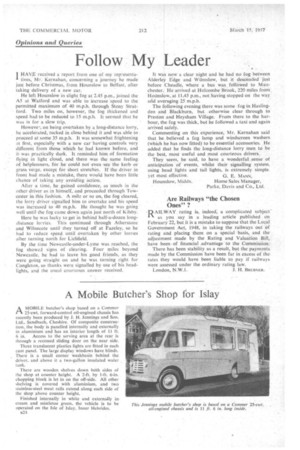Opinions and Queries
Page 58

If you've noticed an error in this article please click here to report it so we can fix it.
Follow My Leader
I HAVE received a report from one of my representa tives, Mr. Kernahan, concerning a journey he made just before Christmas, from Hounslow to Belfast, after taking • delivery of a new car.
He left Hounslow in slight fog at 2.45 p.m., joined the AS at Watford and was able to increase speed to the permitted maximum of 40 m.p.h. through Stony Stratford. Two miles on, however, the fog thickened and speed had to be reduced to 15 m.p.h. Jr seemed that he was in for a slow trip.
Howeve~, on being overtaken by a long-distance lorry, he accelerated, tucked in close behind it and was able to proceed at some 35 [m.p.h. It was somewhat frightening at first, especially with a new car" having controls very different from those which he had known before, and it was. practically dark. Jr reminded him of formation flying in light cloud, and there was the same feeling of helplessness, for he could not even see the kerb or grass verge, except for Short stretches. If the driver in front had made a mistake, there would have been little chance of taking any avoiding action.
After a time, he gained confidence, as much in the other driver as in himself, and proceeded through Towcester in this fashion. A mile or so on, the tog cleared, the lorry driver signalled him to overtake and his speed was increased to 40 m.p.h. He thought he was going well until the fog came down again just north of Kilsby.
Here he was lucky tO get in behind half-a-dozen longdistance lorries. This continued through Athcrstone and Wilnecote until they turned off at Fazeley, so he had to reduce speed. until Overtaken by other lorries after turning north for Lichfield.
By the time Newcastle-under-Lyme was reached, the fog showed signs of clearing. Four miles beyond Newcastle, he had to leave his good friends, as they were going straight on and he was turning right for Congleton, so thanks were signalled by use of his headlights, and the usual courteous answer received. ft was now a clear night and he had no fog between Alderley Edge and Wilmslow, but it descended just before Cheadle, where a bus was followed to Manchester. He arrived at Holcombe Brook, 220 miles from Hodnslow, at 11.45 p.m., not having stopped on the way atid averaging 25 m.p.h.
The following evening there was some fog in Haslingden and Blackburn, but otherwise clear through to Preston and Heysham Village. From there to the harbour, the fog was thick, but he followed a taxi and again arrived safely.
Commenting on this experience, Mr. Kernahan said that he believed a fog lamp and windscreen washers (which he has now fitted) to be essential accessories. He added that he finds the long-distance lorry .men to be the best, most useful and most courteous drivers.
They seem, he said, to have a wonderful sense of anticipation • of events, whilst their signalling system. using head lights and tail lights, is extremely simple.
yet most .effective. G. E. MANN,
Hounslow, Middx. Home Sales Manager, Parke, Davis and Co., Ltd.
Are Railways "the Chosen . Ones" ?
'R AILWAY rating is, indeed; a complicated subjectas you say in a leading article published on February 22, but it is a mistake to suppose that the Local Govonment Act, 1948, in taking the railways out of rating and placing them on a special basis, and the adjustment made by the Rating and Valuation Bill, have been of financial .advantage to the Commission. There has been stability as a result, but the payments made by the Commission have been far in excess of the rates they would have been liable to pay if railways were assessed under the ordinary rating law.
London, N.W.1. .I. H. BRERNER.




































































































